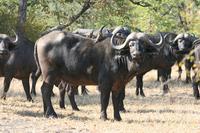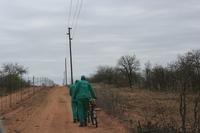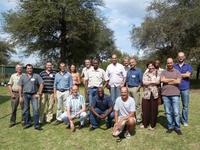FMD Epidemiological Network - CORUS FMD
Last update: 7 June 2012
Dates: 2008-2011
FMD is one of the many contagious transboundary diseases that can spread rapidly within the livestock population and have a negative economic impact in the region. In Southern Africa, several wildlife species are reservoirs of the virus, particularly the African Buffalo (Syncerus cafer) and to a lesser extent some species of antelope such as impala (Thomson et al. 2003;Vosloo et al. 2006;Vosloo et al. 2008) and kudu. Traditionally in Southern Africa, the control and prevention of FMD relies largely on three major strategies:
- The erection of fences to separate wildlife reservoirs (primarily African buffalo) from cattle.
- Vaccination of cattle living in areas adjacent to wildlife areas in order to reduce the population of susceptible cattle and limit the spread of the virus, should transmission from wildlife occur.
- Stamping out
The choice of these strategies depends on the situation of FMD in the country, and the relative importance of the beef industry for international trade.
Main objective
Develop a regional network between Zimbabwe, Mozambique and RSA in order to improve the knowledge of the dynamics of FMD in the GLTFCA considering the possible different kinds of interface between wildlife and livestock and different kinds of scenarios.
Secondary objectives
Develop epidemiological tools to :
- measure the risk of occurrence of new FMD outbreaks resulting from contacts at the wildlife/livestock interface.improve our understanding regarding the transmission of FMD among animal populations of domestic and wild animals.
- evaluate the efficiency of control strategies in order to design more efficient measures of surveillance and control.
- Improve capacity building on the development of epidemiological tools and methods in the region.
- Exchange information about FMD surveillance in the GLTFCA that could be used as a source of data for epidemiological studies.
Development of scientific project activities
- Evaluation of the efficiency of FMD control systems within the GLTFCA
- Evaluation of fence permeability and wildlife/cattle contacts
- KNP fence permeability in South Africa
- Wildlife /cattle contacts in the KNP interface, South Africa.
- Wildlife cattle contacts in Zimbabwe
- Evaluation of fence permeability and wildlife/cattle contacts
-
- Vaccination in adjacent livestock areas
- Efficiency study on the bivalent vaccine in the LNP interface
- Efficiency of the trivalent vaccine in GNP interface
- Vaccination in adjacent livestock areas
- Development of a quantitative risk assessment to assess the risk of transmission of FMD virus at the wildlife livestock interface
- Capacity building
- Networking and Coordination
Last update: 7 June 2012




